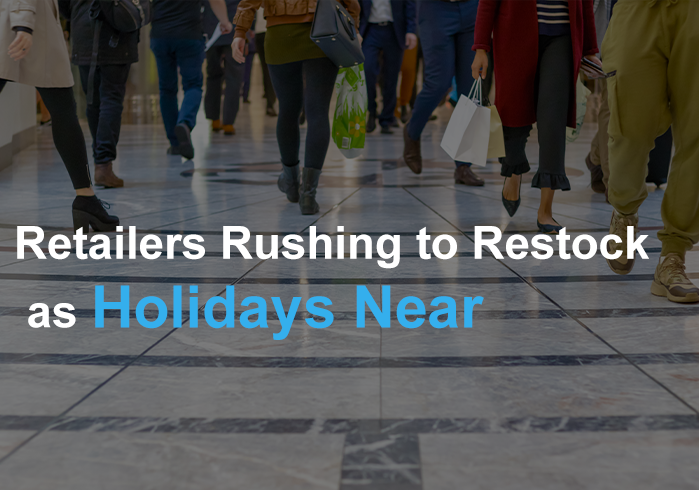
The latest logistics report indicates several patterns that should be of interest or even concern to the entire shipping industry. First, retailers are rushing to restock their stores in preparation for the holiday season which means increased demand for shipping services. It then becomes a sellers’ market where transport costs continue to rise as ship operators leverage their superior position.
Meanwhile consumers continue to gobble up inventory while available space for shipping narrows. There is confidence in the strength and durability of the demand upsurge that happened towards the end of the worst phases of the COVID-19 pandemic. This is most likely a reflection of the increased preference for online shopping as people have become more accustomed to social distancing.
Statistical evidence of stocking up
A quick glance at the regular update shows that the likes of Best Buy and Target are reporting big inventory on their balance sheets. This is a reflection of a holiday season that is promising much according to Lydia O’Neal of the Wall Street Journal (WSJ) Logistics. Nevertheless, people should be wary of underestimating the Delta variant of COVID-19 which has the potential to cause significant problems if not managed well.
Certainly, supply chain disruptions may continue to plague this industry. It is a period of uncertainty due to the difficulties of forecasting the market following the upheavals that the pandemic unleashed on it. This is an era of estimates that never quite hit the mark.
Challenges of forecasting in the COVID-19 era
The pandemic was all-encompassing. It brought a standstill to some operations and many staff members in the shipping industry were affected as purchasing patterns changed. In the beginning, consumers were saving up for the possible rainy days to come and later, they were doing online shopping to avoid potential exposure to COVID-19. Indeed, some consumers had become so used to virtual life that they were unwilling to go back to the old normal when restrictions were eased.
Despite the difficulties in forecasting, it seems that retailers are certain this is going to be a prosperous holiday season. Otherwise, they would not be stocking up. That is why some experts argue that retailers have judged that the risk of empty shelves is greater than the risk of overstocking.
Reality of escalating transportation costs
Because the shipping industry is already in operational turmoil, this analysis adds to the sense of urgency and perhaps panic. Those that have no inventory might find that it is increasingly difficult and expensive to get their suppliers into the outlets. For example, we know that Walmart and Home Depot have resorted to chartered vessels to ensure that their supply chain is not disrupted.
The infrastructure of the shipping industry is struggling to keep up with this demand for goods and shipping space. We are already seeing a backup of container ships that are anchored off Long Beach and Los Angeles. Recently, up to 65 individual vessels were waiting in line to be cleared. Conservative estimates are that up to 600,000 containers are stuck on water.
In such circumstances, it is not surprising that transportation costs are hitting the roof. Every major global supply chain is dealing with an increase in demand. The lucrative routes are getting the ships that were originally meant for the less lucrative ones. We continue to hear stories of ships being taken off the African and Middle East routes so that they can provide additional capacity to the higher paying trans-Pacific routes.
Limited cost-reduction approaches
While transportation costs used to be nothing more than an afterthought, they are now a real priority as the rising costs are not predictable. The idea that these costs can be quickly passed on to consumers is not practical given the competition of the retail sector. If you are overpriced, consumers will move elsewhere leaving you stuck with excess inventory.
Some companies have become overwhelmed by the sheer rise in the cost of doing business. Transportation is adding to the base costs and yet consumers are not willing to pay higher prices. Perhaps the holiday season will open a pathway for companies with inventory to provide alternatives to those retailers that have empty shelves. The current market situation may run as far as 2023 so the industry must engage in a wide-ranging restructuring process for long-term solutions to this challenge.
There are reports coming out of Molson Coors, 3M, Mondelez International, and Dollar Tree to the effect that transportation costs are having a negative impact on their business models. Jo-Ann Stores have also reported a 10-fold increase in its historical costs for some products. This is not a problem that is restricted to individual retails but has implications for the wider economy.
By 2020, transportation costs accounted for over 5% of GDP. This is the highest level recorded in the last 10 years according to data from the annual State of Logistics report. Yet, 2021 has seen even bigger increases in the cost of transportation. For example, the Cass Freight Index for expenditures reported a record high in August 2021 which represented an increment of about 35% of the same month two years ago.
Preparing for a hectic holiday season
Since rising costs are an inevitable part of the logistics industry, there must be other preparations that can contend with the increased demand expected during the holiday season. Supermarkets are responding to the increased demand by stocking up on seasonal items such as cranberry sauce, spices, and turkeys. The last thing they want, or need, are the empty shelves that blighted the season in 2020.
Early buying is a clever strategy for pulling forward with procurement. The pandemic has taught everyone the value of planning and preparing. The holiday season may hold surprises, but many retailers are prepared for anything. Meanwhile the shipping industry must cope with this increased activity despite the internal logistical challenges it has been grappling with in the last two years.
Wrapping up
The holiday season will soon be upon us and all indications are that consumers will be buying. Supermarkets and other retailers are stocking up. This places demand on a shipping industry that has been battered by the COVID-19 pandemic and is only getting used to the unexpected increase in demand for goods at the tail end of the worst phases of the COVID-19 pandemic.



